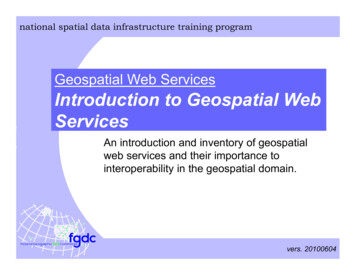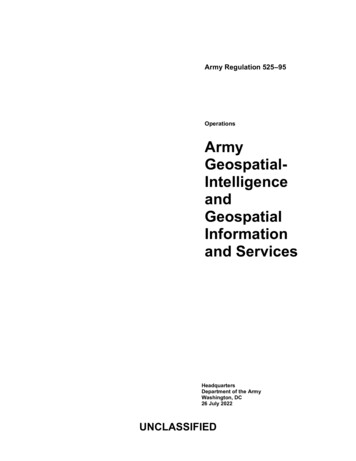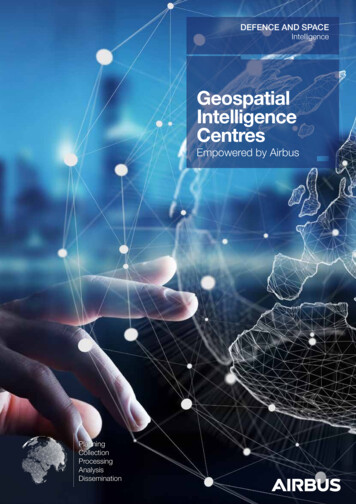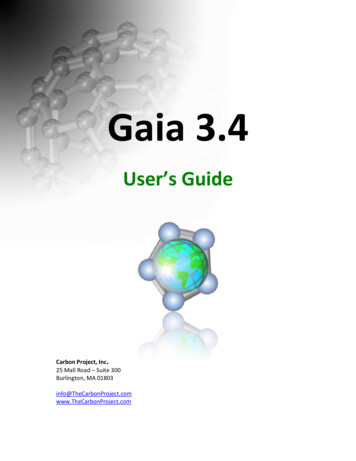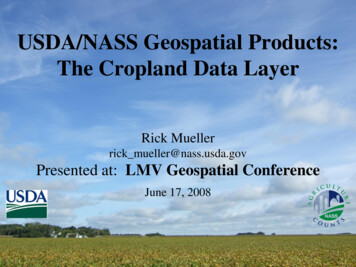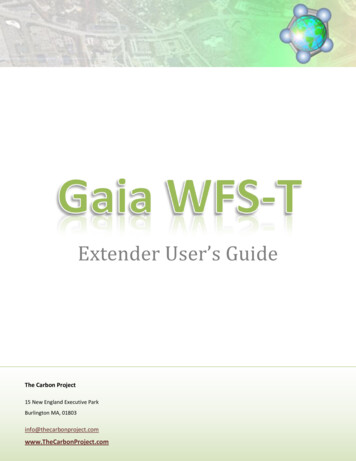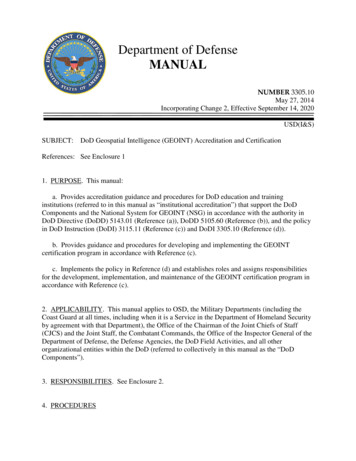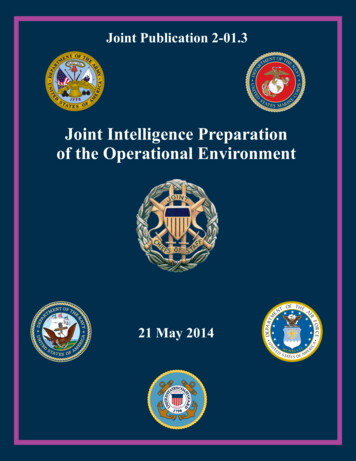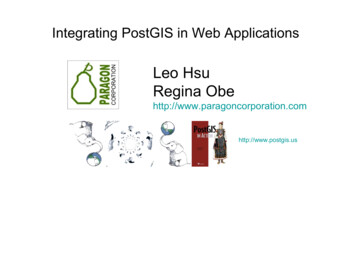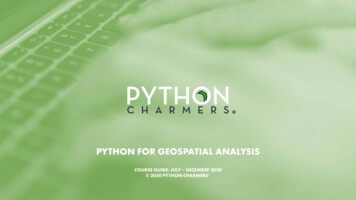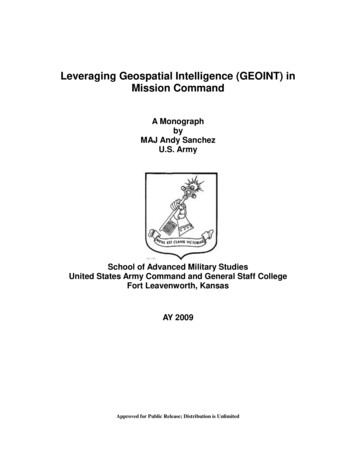
Transcription
Leveraging Geospatial Intelligence (GEOINT) inMission CommandA MonographbyMAJ Andy SanchezU.S. ArmySchool of Advanced Military StudiesUnited States Army Command and General Staff CollegeFort Leavenworth, KansasAY 2009Approved for Public Release; Distribution is Unlimited
Form ApprovedOMB No. 0704-0188REPORT DOCUMENTATION PAGEPublic reporting burden for this collection of information is estimated to average 1 hour per response, including the time for reviewing instructions, searching existing data sources, gathering and maintaining thedata needed, and completing and reviewing this collection of information. Send comments regarding this burden estimate or any other aspect of this collection of information, including suggestions for reducingthis burden to Department of Defense, Washington Headquarters Services, Directorate for Information Operations and Reports (0704-0188), 1215 Jefferson Davis Highway, Suite 1204, Arlington, VA 222024302. Respondents should be aware that notwithstanding any other provision of law, no person shall be subject to any penalty for failing to comply with a collection of information if it does not display a currentlyvalid OMB control number. PLEASE DO NOT RETURN YOUR FORM TO THE ABOVE ADDRESS.1. REPORT DATE (DD-MM-YYYY)2. REPORT TYPE21-05-2009Monograph3. DATES COVERED (From - To)July 2008-May 20094. TITLE AND SUBTITLE5a. CONTRACT NUMBERLeveraging Geospatial Intelligence (GEOINT) in the CognitiveHieraHierarchy of Mission Command5b. GRANT NUMBER5c. PROGRAM ELEMENT NUMBER6. AUTHOR(S)5d. PROJECT NUMBERMAJ Andy Sanchez5e. TASK NUMBER5f. WORK UNIT NUMBER8. PERFORMING ORGANIZATION REPORTNUMBER7. PERFORMING ORGANIZATION NAME(S) AND ADDRESS(ES)ANDADDRESS(ES)AdvancedMilitaryStudies Program250 Gibbon AveFort Leavenworth,KS 66027-21310. SPONSOR/MONITOR’S ACRONYM(S)9. SPONSORING / MONITORING AGENCY NAME(S) AND ADDRESS(ES)SAMS, CGSCCommand and General Staff College1 Reynolds100StimsonAveFort Leavenworth, KS 6602711. SPONSOR/MONITOR’S REPORTNUMBER(S)12. DISTRIBUTION / AVAILABILITY STATEMENTApproved for Public Release; distribution is unlimited13. SUPPLEMENTARY NOTES14. ABSTRACTThe federal government response to Hurricane Katrina demonstrated a vital need for the military to improve the process for assessment, response, anddecision-making for all organizations involved. Geospatial Intelligence (GEOINT) is an emerging intelligence discipline that provides detailed dataanalysis, an assessment of the operational environment, and a means to investigate problems that may emerge. GEOINT is the exploitation and analysis ofimagery and geospatial information to describe, assess, and visually depict physical features and geographically referenced activities. By examining the useof geospatial information systems by civilian organizations use of during Hurricane Katrina, it was possible to observe that the U.S. Combatant Commandsare underutilizing GEOINT’s potential as a tool for information analysis. Faced with new and complex problems, the military must adapt not only itsmethods for understanding complex problems but also must integrate new technologies to inform Mission Command.GEOINT provides the decision-maker or commander the ability to attain shared understanding of the operational environment. Joint and Armyplanning both recognize GEOINT but do not provide a vehicle to reveal its capabilities or how those capabilities can assist the commander with situationalunderstanding. Joint and Army planners in COCOMs must follow NORTHCOM’s lead and exploit GEOINT modeling capabilities in preparing for newand emerging threats. The employment of GEOINT modeling capabilities provides decision-makers the ability to visualize the environment prior toconducting operations. The military planners’ limited understanding of GEOINT’s capabilities and their tendency to focus on the limited number of usefuldata sources retards exploitation of geospatial intelligence capabilities in military operations planning. The value of GEOINT lies in its ability to bringanalysis to inform all stages of commander visualization in mission command.15. SUBJECT TERMSGeospatial Intelligence (GEOINT), Geographic Information Systems, Mission Command16. SECURITY CLASSIFICATION OF:17. LIMITATIONOF ABSTRACTUnclassifieda. REPORTb. ABSTRACTc. THIS PAGEUNCLASSIFIEDUNCLASSIFIEDUNCLASSIFIED18. NUMBEROF PAGES19a. NAME OF RESPONSIBLE PERSONStefan J. Banach,COL ,U.S. Army19b. TELEPHONE NUMBER (include areaUNLIMITED48code)913-758-3302Standard Form 298 (Rev. 8-98)Prescribed by ANSI Std. Z39.18
SCHOOL OF ADVANCED MILITARY STUDIESMONOGRAPH APPROVALMAJ Andy SanchezTitle of Monograph: Leveraging Geospatial Intelligence (GEOINT) in MissionCommandApproved by:William J. Gregor, Ph.D.Monograph DirectorStefan Banach, COL, INDirector,School of AdvancedMilitary StudiesRobert F. Baumann, Ph.D.Director,Graduate DegreePrograms
AbstractLEVERAGING GEOSPATIAL INTELLIGENCE (GEOINT) IN THE COGNITIVEHIERARCHY OF MISSION COMMAND by MAJ Andy Sanchez, U.S. Army, 58 pages.The federal government response to Hurricane Katrina demonstrated a vital need for themilitary to improve the process for assessment, response, and decision-making for allorganizations involved. Geospatial Intelligence (GEOINT) is an emerging intelligence disciplinethat provides detailed data analysis, an assessment of the operational environment, and a means toinvestigate problems that may emerge. GEOINT is the exploitation and analysis of imagery andgeospatial information to describe, assess, and visually depict physical features andgeographically referenced activities. By examining the use of geospatial information systems bycivilian organizations use of during Hurricane Katrina, it was possible to observe that the U.S.Combatant Commands are underutilizing GEOINT’s potential as a tool for information analysis.Faced with new and complex problems, the military must adapt not only its methods forunderstanding complex problems but also must integrate new technologies to inform MissionCommand.GEOINT provides the decision-maker or commander the ability to attain sharedunderstanding of the operational environment. Joint and Army planning both recognize GEOINTbut do not provide a vehicle to reveal its capabilities or how those capabilities can assist thecommander with situational understanding. Joint and Army planners in COCOMs must followNORTHCOM’s lead and exploit GEOINT modeling capabilities in preparing for new andemerging threats. The employment of GEOINT modeling capabilities provides decision-makersthe ability to visualize the environment prior to conducting operations. The military planners’limited understanding of GEOINT’s capabilities and their tendency to focus on the limitednumber of useful data sources retards exploitation of geospatial intelligence capabilities inmilitary operations planning. The value of GEOINT lies in its ability to bring analysis to informall stages of commander visualization in mission command.i
Table of ContentsLIST OF ILLUSTRATIONS . iiiIntroduction . 1What is GEOINT? . 6GEOINT in Joint Operations . 10Examining Hurricane Katrina: A Case Study. 14GEOINT’s Role: Not Much Went Right . 15Hurricane ―Pam‖ . 18GEOINT’s Role: Post Landfall Hurricane Katrina . 20Mission Visualization: Hurricane Katrina . 24Communicating Requirements for GEOINT Modeling . 30Conclusion . 36Bibliography . 40ii
LIST OF ILLUSTRATIONSFigure 1. GEOINT's comprehensive integration of intelligence and imagery databases . 7Figure 2: ArcGIS for Situational Awareness helps turn data into actionable information . 26Figure 3: HAZUS-MH provides federal and state agencies potential damage estimates. . 28iii
IntroductionThe recent wars in Iraq and Afghanistan and the federal government response toHurricane Katrina have demonstrated a vital need for the military to improve the process forassessment, response, and decision-making. Concepts such as operational art and Design claim toprovide ―a way‖ to frame the operational problem, but neither method actually improve thecommander’s ability to understand the situation. Some processes, such as operational art anddesign, fall short of answering important questions and translate easily into missions that soldierscan execute. Military commands and staffs start situation assessment by examining a map. EnterGeospatial Intelligence or (GEOINT); an emerging intelligence discipline that provides detaileddata analysis, an assessment of the operational environment, and a means to investigate problemsthat may emerge. GEOINT is the exploitation and analysis of imagery and geospatial informationto describe, assess, and visually depict physical features and geographically referenced activitieson the Earth.1 Faced with new and complex problems, the military must adapt not only itsmethods for understanding complex problems but also must integrate new technologies to informthe cognitive hierarchy of Mission Command.Warfare is complex. Add to the conventional concept of warfare, the unpredictablecomponents of culture, religion, political ideology, and friction2 and the complex militaryproblem evolves into an ill-structured problem.3 Emerging planning methods such as Design seekto frame a complex problem through a rigorous form of questioning that can ultimately lead to a1Department of Defense. Joint Publication 2-03. Geospatial Intelligence Support to JointOperations. 31 March 2007.pg vii2Carl Von Clausewitz (1976, rev.1984). On War. edited and translated by Michael Howard andPeter Paret. Princeton: Princeton University Press. Clausewitz refers the friction of war that will ultimatelykeep war limited, unpredictable, and dangerous.3US Army Training and Doctrine Command, TRADOC Pamphlet 525-5-500, Commander’sAppreciation and Campaign Design, Version 1.0 (Fort Monroe, VA: GPO, 28 January 2008), 6. An IllStructured Problem is the most interactively complex, non-linear, and chaotic –and therefore the mostchallenging. Unlike well- or medium-structured problems, professionals will disagree about how to solvethis type of problem, what should be the end state, and whether the desired end state is even achievable.1
theory of action. Where Design falls short is through its neglect of GEOINT’s proven methods.When used appropriately, GEOINT can eliminate the need for planning assumptions by revealingfacts and enabling the assessment of alternative responses. GEOINT technology enables themilitary, national intelligence, and engineering communities to interact simultaneously to developa two or three dimensional digital map displays of large amounts of layered data. Thecollaborative data display facilitates collaborative analysis. GEOINT permits detailed dataanalysis that supports the decision maker by providing him better situational understanding.Unfortunately, Army planners do not understand the important role geographic informationsystems can serve in informing Battle Command or joint operations planning.In the contemporary operating environment, GEOINT can be employed at all levels ofwar. GEOINT is most useful at the tactical level, for planning. At the tactical level GEOINTmerges imagery intelligence with geophysical maps. The military customer of GEOINT generallyexpects the analyst to provide him a printed map or some form of two or three dimensional digitaldisplay. In most cases the value-added by GEOINT is embedded in the finished product’simagery and graphic intelligence. But GEOINT technology is evolving quickly in the private andcivilian government sectors to support business ventures and government agencies. The militaryis missing opportunities to capitalize on GEOINT technology by not incorporating its capabilitiesinto the warfighting community.4 Lt. General Clapper has observed,GEOINT is about more than pictures. GEOINT makes possible in-depthassessments and judgments based on the information that is gleaned from visualdepictions. In short, GEOINT is more than imagery, maps, charts and digitaldisplays showing where the bad guys are. GEOINT at its best is the analysis thatresults from the blending of all of the above into a dynamic, composite view offeatures or activities—natural or manmade—on Earth.54Jim Youker. ―Geo-enabled PDF Usher In a New Era.‖ GIS Development: The Global GeospatialMagazine. Volume 12, Issue 10. October 2008.pg 35James R. Clapper, Jr., Lieutenant General. 2004. ―Imagine the power of GEOINT,‖Pathfinder:The Geospatial Intelligence Magazine.May-June. National Geospatial Intelligence Agency.pg6.2
Although Lieutenant General Clapper’s example illustrates one GEOINT use, it is only asmall portion of GEOINT’s capabilities. GEOINT’s true potential lies in its ability to predictsituations through the construction of analytical models. The models can provide a commanderand his planning team means by which to forecast changes and effects in their area of operation toprovide context and improve understanding. Brigadier General (Ret) Huba Wass de Czegeemphasizes the importance of emerging methods to assist commanders to achieve betterunderstanding. He wroteOperational artists at all levels need new conceptual tools commensurate totoday’s demands. Conceptual aids derived from old, industrial-age analogies arenot up to the mental gymnastics demanded by 21st –century missions. Becauseoperational environments evince increasingly dynamic complexity, commandersare looking for, and are in need of, help.6GIS modeling tools are that help. Modeling is made possible through the employment of softwarecomponents within a GEOINT program. The program provides a standard platform for spatialanalysis, data management, and mapping. Used properly, GEOINT provides the commander andhis planning team with useful predictions derived from models that support assessments andcreates a more accurate projection of the situation and the operational environment.Private enterprise and civil government communities have used geographic informationsystems for several years. The capabilities of geographic information systems7 used duringdisaster response and homeland security planning are just beginning to be exploited.Geographic information systems integrate hardware, software, and data forcapturing, managing, analyzing, and displaying all forms of geographicallyreferenced information. Geographic information systems allows a user to view,understand, question, interpret, and visualize data in many ways that revealrelationships, patterns, and trends. When displayed in map, report, or chartformat, GIS allows the user to answer questions and solve problems byexamining data rapidly and collectively.86Huba Wass de Czege, Brigadier General (Ret), U.S. Army. ―Systemic Operational Design:Learning and Adapting in Complex Missions.‖ Military Review January-February 2009. pg 2.7ESRI. GIS.com. October 1, 2008. http://www.gis.com/whatisgis/ (accessed April 24, 2009).8Ibid, 13
A geographic information system is an embedded software capability of the GEOINT process.Unfortunately, the military fails to reference geographic information systems as a vitalcomponent of the GEOINT process in Joint or Army Doctrine.If the military’s use of geographic information during the response to Hurricane Katrinais compared with geographic information systems use by civilian responders, it is possible toidentify the military planner’s limited conception of geographic information. The employment ofGEOINT modeling capabilities simply recognizes the importance of testing an initial hypothesisand assumptions during mission analysis. Contemporary application suggests the underutilizationof GEOINT’s full potential as a product for information analysis by COCOM and Army planningstaffs. If NORTHCOM’s expanded use of geospatial information systems for planning anddisaster response is examined, it is possible to identify the key elements of mission command asoutline in FM 6-0 that are supported by geospatial intelligence. The military planners limitedunderstanding of GEOINT’s capabilities and a tendency to focus on the limited number of usefuldata sources retards exploitation of geospatial intelligence capabilities in military operationsplanning. Therefore, a commander’s visualization aided and enhanced with geographicinformation systems can significantly improve mission command.The potential value of GEOINT lies in its ability to bring analysis to inform all stages ofcommander visualization in mission command. According to Chapter 4 of Field Manual 6-0Mission Command, commander’s visualization consists of the mental process of achieving a clearunderstanding of the force’s current state with relation to the enemy and environment.Commanders continuously visualize military operations through situational understanding,operations planning, execution, and assessing.9 First, he must develop situational understanding.That is, the commander must understand the situation at the outset of a planning effort.9Department of the Army. Field Manual 6-0: Mission Command. Washington, D.C.: Departmentof the Army, 2003. p.4-0.4
GEOINT’s robust database can rapidly filter relevant from irrelevant data to answer specificquestions a commander must answer to attain situational understanding. Processed data is layeredon a map and shared with subordinate units for further analysis. The more accurate the data andinformation, the faster a commander achieves understanding of his environment.Second, the commanders must visualize where to go, how operations will unfold, andunderstand how well his forces are doing. Visualization in operations begins with planning andcontinues throughout the execution until the force accomplishes the mission. The commanderfocuses the staff’s planning efforts by providing intent, planning guidance, and commandercritical information requirements. GEOINT technology can assist the commander and staff,through modeling and simulation to determine how the enemy views its operations in time andspace. Next, visualization in execution represents the commander’s assessment of how welloperations are succeeding and if any adjustments are needed improve performance or achievesuccess. GEOINT’s embedded common operating picture provides the commander the ability tokeep visualization current.Finally, assessment occurs during all stages of visualization in mission command. Thecommander relies initially on personal experience, the staff, and assessments from units executingthe mission. GEOINT’s ability to organize data, query specific information, and provide trendanalysis aids the continuous process of assessment throughout all stages of visualization. TheGEOINT process, enabled by the detailed analysis of geographic information systems, providesthe commander with the science that complements the commander’s employment of the art ofwar. Geographic information systems assist a commander’s visualization by providing softwaretools that permit a complex, multi-dimensional data display that more accurately represents thesituation and permits estimates, forecasts, and prediction. GEOINT aids Mission Command byestablishing a basis for shared understanding and the ability to analyze layered data to facilitateparallel planning for subordinate units.5
What is GEOINT?Geospatial intelligence (GEOINT) supports joint forces in their ability to respond tothreats around the world. Geo-referenced visual data products serve as a foundation and commonframe of reference for any joint operation.10 GEOINT is the exploitation and analysis of imageryand geospatial information to describe, assess, and visually depict physical features andgeographically referenced activities on the Earth.11 GEOINT consists of imagery, imageryintelligence (IMINT), and geospatial information.12 GEOINT is currently employed at thestrategic, operational, tactical levels to support the military, national security and homelandsecurity planners. The United States Army Corps of Engineers and members of the IntelligenceCommunity also use GEOINT to inform private and public sector decision makers.13 Peoplefamiliar with GEOINT, normally see mapping or some kind of imagery product. GEOINTproducts, however, combine imagery with layered data from other intelligence disciplines such asHuman intelligence (HUMINT), Signal Intelligence (SIGINT), Measurement and SignaturesIntelligence (MASINT), and Open-Source Intelligence (OSINT).14 This combination providesusers with a comprehensive and continuously growing source of information to produce digitalmap products. The information is an integral part of the map product and can be accessed, shared,and analyzed by multiple users in a timely manner. Figure 1 depicts how GEOINT is a part of thecomprehensive response to the integration of the intelligence process.10JP 2-03, viiIbid, vii12Ibid, vii13Ibid ,714Ibid, 9116
Figure 1. GEOINT's comprehensive integration of intelligence and imagery databasesThe military does not conduct GEOINT operations in isolation. GEOINT consists ofmany ongoing operations and activities across the Department of Defense (DOD).15 In militaryoperations GEOINT fuse multiple components of intelligence and imagery intelligence.TheGEOINT product serves as an interactive geospatial framework to aid the commander’ssituational understanding of the environment. GEOINT assists the commander efforts to visualizethe operational situation during planning and execution. By organizing data and information intomap layers the critical components of the operational environment as outlined in FM 3-0, arevisually depicted on a digital map. The ability to integrate data from the Political, Military,Economic, Social, Information, Infrastructure, Physical environment and Time (PMESII-PT)16 in15Department of the Army, Headquarters. FM 2-0 Intelligence w/change 1. 2004Department of the Army, Headquarters. FM 3-0 Operations. 27 February 2008. pg 1-5.Operational Variables allow planners to describe the operational environment and the population’s impacton said variables. The Operational Variables consist of the polticial, military, economic, social,information, infrastructure and can include the physical environment and time. Since a population’s impacton military operations are unique from one theater to the next it is important that Operational Variables beanalyzed within the context of the specific environment.167
a layered data-base linked to a digital map assists the commander in attaining situationalunderstanding. When combined with an interactive map, the aforementioned components of theoperational environment enable insight into to present and future operations. GEOINTthereforeenhances the ability to anticipate requirements through accurate estimates, forecasts, andtrend analysis. For example, a commander operating within a neighborhood of Iraq is attemptingto understand why criminal activity is increasing in a particular part of his area of responsibility.Using GEOINT layered data on an existing digital map he can ask his intelligence analyst to sortcriminal activity by type, date, time, and location. He can then organize this data further bysorting and analyzing the same criminal activity to see if it may relate to a potential disparity inincome levels, or possible differences in religious and political affiliations between differencesections of the populace.The GEOINT discipline is the specialized field of practice within the broader professionof intelligence. The Department of Defense recognizes the potential capability of geographicinformation systems technology to provide a richer, more detailed, and useful picture. GEOINTcan be collected on a specific area and organized by data layers into categories such asinfrastructure, and demographic and cultural information. The data layers combine with a multifunctional two or three dimensional map product that multiple users in different location canaccess simultaneously. GEOINT provides the commander with a three-dimensional context, inwhich the decision maker is more likely to comprehend divergent pieces of information, reach adecision, and initiate action.17 When used in this capacity, GEOINT enables the commander’svisualization in operations, execution, and assessment.17John Doty. Geospatial Intelligence: ―An Emerging Discipline in National Intelligence with anImportant Security Assistance Role.‖ The DISAM Journal, Spring 2005. pg 5)8
GEOINT consists of four fundamental components: the discipline of GEOINT, the datathat comprise GEOINT, the process used to develop GEOINT products, and the products derivedfrom GEOINT:1.Discipline. The GEOINT discipline encompasses all activities involved in theplanning, collection, processing, analysis, exploitation, and dissemination ofgeospatial information to gain intelligence about the operational environment,visually depict of this information, and fuse the visual information with otherinformation through analysis and visualization processes.2. Data. GEOINT is developed from the same geospatially-derived data used tocreate geospatial information, imagery, and IMINT. The full capabilities ofGEOINT are only realized when two or more types of data are combined andanalyzed to create a comprehensive GEOINT product.3. Process. The analytic methodology used by NGA is known as GEOINTpreparation of the environment (GPE). GPE supports joint intelligencepreparation of the operational environment (JIPOE). It is a proven methodologyand, of equal importance, it provides a common frame of reference and languagebetween military and civilian personnel.4. Products. GEOINT products range from standard geospatial data-derivedproducts, maps, and imagery to specialized products that incorporate data frommultiple types of advanced sensors and use four dimensions.18The data component of GEOINT aids the commander in the process of decision making. Dataanswers the ―so what‖ of the commander’s guidance and intent and the commander’s criticalinformation requirements. Aggregate raw data becomes information through management(organization and discipline) which organizes the data into systems, analysis, processing, andexploitation. Staff members then place information within the context of their experience, and theinformation becomes knowledge. The sum of the knowledge, over time and within a spatialcontext, creates within the mind of the commander the understanding required to make effectivedecisions.19 The value of GEOINT lies in its ability to take geographic location, the most simplebut fundamental component of everyday life, and add geographic relevant data such as theoperational variables identified as PMESII-PT to describe a specific environment. Once the data1819National System for Geospatial Intelligence (GEOINT) Basic Doctrine Version 1.0, NGA. 2006Ibid, 169
is incorporated into an interactive map the visual display improves the commander’s visualizationthroughout the military decision making process.GEOINT in Joint OperationsGeospatial intelligence support has only recently appeared in the joint doctrine and is notaddressed in Army operations doctrine. GEOINT provides an analytical framework for georeference battlefield information and displays the results in a common picture of strategic,operational, and tactical environments. Joint Publication 2-03 Geospatial Intelligence Support toJoint Operations states that Combatant Commands (COCOMs) utilize GEOINT to develop areaand point targets while supporting the planning and execution of joint operations. Fundamental toGEOINT’s integration in joint operations is the establishment of a Joint Operations IntelligenceCell (JOIC). The JOIC, integrates and employs GEOINT capabilities in support of planning andexecution of Joint Operations.20 Although Joint Publication 2-03 establishes a method foremploying GEOINT capabilities, the manual provides no specific guidance on how to make bestuse of geospatial intelligence. GEOINT has the potential to provide the base from which acommander and his staff can gain shared understanding of the operational environment.GEOINT provides the framework for intelligence preparation of the battlefield andplanning before, during, and after a conflict. The GEOINT cell assigned to combatant commandscoordinates all GEOINT requirements within the area of responsibility. Supporting commands orcomponents additionally execute theater and mission-specific GEOINT requirements in supportof COCOMs to enable a common operating picture (COP) with a GEOINT framework.21Geospatial intelligence provides the commander and staff with a visual picture of the battle space.The COP is essential for a commander’s visualization in execution. Subordinate units sharing aDepartment of Defense. Joint Publication 2-03. Geospatial Intelligence Support to JointOperations. 31 March 2007.pp x-xi.21JP 2-
Geospatial Intelligence (GEOINT) is an emerging intelligence discipline that provides detailed data . US Army Training and Doctrine Command, TRADOC Pamphlet 525-5-500, Commander's . . The program provides a standard platform for spatial analysis, data management, and mapping. Used properly, GEOINT provides the commander and

